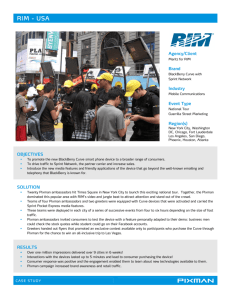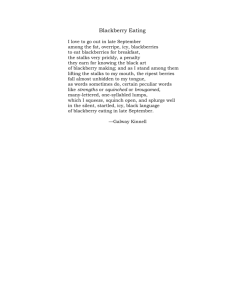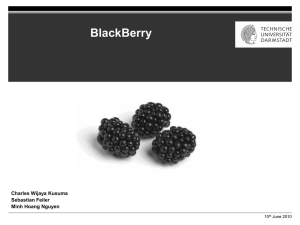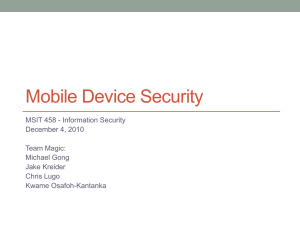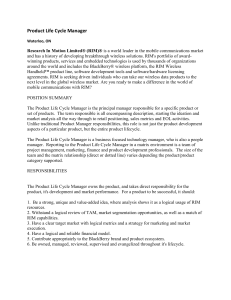Smartphone Market
advertisement
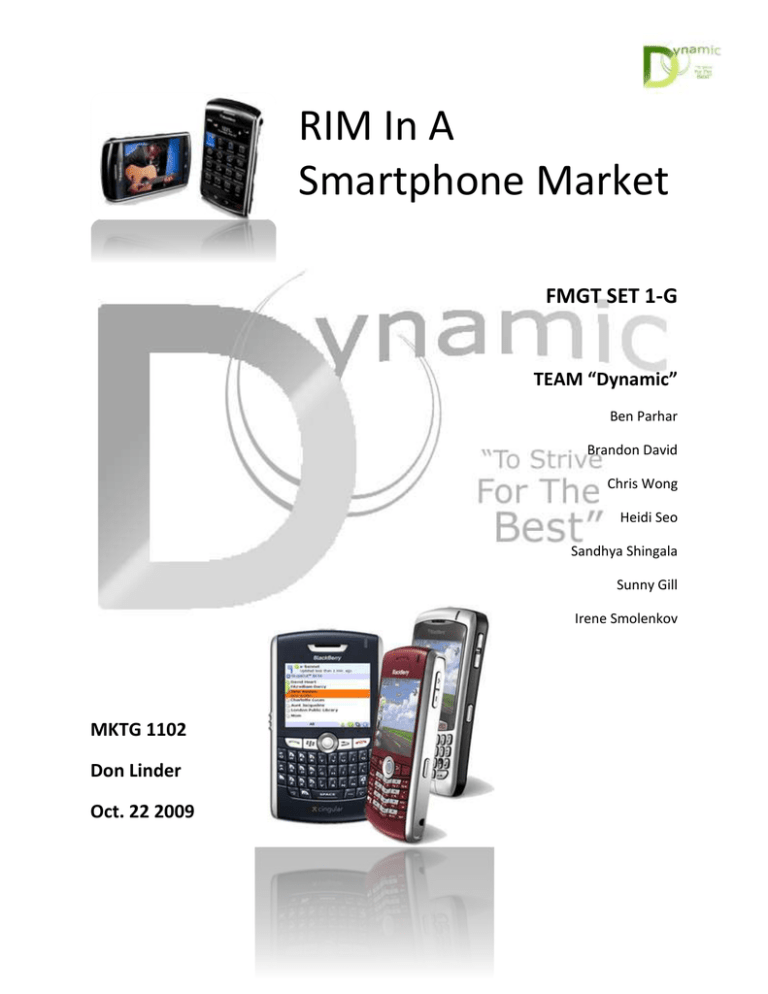
RIM In A Smartphone Market FMGT SET 1-G TEAM “Dynamic” Ben Parhar Brandon David Chris Wong Heidi Seo Sandhya Shingala Sunny Gill Irene Smolenkov MKTG 1102 Don Linder Oct. 22 2009 Introduction: Apple has come out with a new version of the iPhone that has overshadowed Blackberry’s Storm. The iPhone 3G has new features including WiFi, Video recorder, more memory, and is relatively inexpensive compared to its competitors. These new features have made the iPhone surpass the Blackberry Storm. RIM must now increase promotion of their Smartphone products. Problems: Research In Motion, the parent company to Blackberry, is in a battle for the future controls of the next generation of mobile internet telecommunications and entertainment devices. RIM has seen its market share in the past years greatly decrease and with the rise of Apple and its iPhone. The big question for RIM is what product strategy can be used to adapt to new technology, and changing consumer behaviour? Key Findings: Blackberry’s Storm Smartphone is RIM’s answer to the iPhone. Even though both devices offer similar features such as; mobile phone, email organiser, internet server, GPS, music and movie entertainment. The Storm is falling behind the iPhone because the majority consumer base for Blackberry has been the professional, executive, industrial market; unlike Apple who is already deep in the market of entertainment devices. Although Apple and RIM are two major players in the fight for dominance in the market share many new players have joined the fight. With these new players the market share is divided into more submarkets and segments, all directly taking pieces of the market which the two giants initially held. Assumptions: We assume RIM has enough funding and resources to market and compete with the iPhone. SWOT Analysis: Strengths Light weight and durable. The layout of the phone is simple and easy to understand. Users seem to find tricks in which to maximize the usability of the phone. Longer battery life than leading competitors + SD card support (expandable memory) Everything related to email is better on the BlackBerry. It is a perfect desktop extension and a secure device for business. RIM has a good reputation due to long time experience in the mobile industry market. Effects of RIM’s Strengths on Our Case Decision: RIM has had a strangle hold on the market share of Smartphone’s for years. Blackberry has developed a very loyal customer base, with many “crackberry” addicts. Also by dominating the professional business world blackberry has insured a customer base, guaranteed to spend money. So, with the future success of Blackberry the success of its mother company RIM is sure to follow. Weaknesses: Screen freezes occasionally / Some glitches Lags at browsing the Internet and slow to develop touch-screen technology Fewer applications than the leading competitors A shrinking market share of RIM, Down 30% Not enough industry developers working for them Expensive (Extra mandatory $45 data plan.) Effects of RIM’s weaknesses on Our Case Decision: Because of the web browsing, user friendly iPhone any glitches are a negative toward potential new customers. Blackberry not only faces competition from Apple but also from others because the capability to access facebook and such websites is now very important and simple. The price of Blackberry devices is also a concern, as Apple now offers its iPhone at a reduced cost. Opportunities: Release a new and updated model with additional features Traditionally, Blackberry phones have been targeted to business professionals only Expand target market to incorporate youth as well as their current business market Wi-Fi, Lime-Wire, HP Add additional downloadable applications Price changes for their mandatory data plan Effects of RIM’s Opportunities on Our Case Decision: There are many opportunities for Blackberry to achieve more success and a larger piece of the market share. With a loyal customer base in place with business professionals Blackberry can place more advertising energy into baiting some of the entertainment minded users. By already adding the Blackberry instant messaging service they have won over many of the youth mobile phone users. Also Blackberry could look into a possible partnership with a P2P music sharing website such as, LimeWire, to compete with the very popular iTunes. Threats: Higher costs could be incurred with releasing a newer or updated model While expanding their target market, to youth, they can lose their previously established target market (business) Direct competition= iPhone and Other Smartphone’s Other mobile companies developing Smartphone features for their regular phones Cheaper prices of other direct competitors’ phones Technological advances, More customization options with a faster internet connection Effects of RIM’s Threats on Our Case Decision: Blackberry has many threats, with many new players in the battle for the market share of the Smartphone world. Not only is growing competition a threat, the possibility of losing already gained customers is a real scare; which may occur if Blackberry pushes too hard to appeal to the youth and turn off their loyal Business professionals. Beyond that there is the possibility of new technology making Blackberry obsolete. Competitive Analysis: Research in Motion’s current and potential competitors are companies that produce Smartphone’s and handheld entertainment devices. Currently, RIM’s main competitors in the Smartphone market are Apple, Nokia, HTC, Palm, Motorola, and Samsung. Nokia controls over 50% of the world’s Smartphone market as it is the world’s largest manufacturer of mobile telephones. RIM currently has a market share of over 50% in the North American Smartphone market with its direct competitor being the iPhone. In the global market of Smartphone’s, Blackberry has a 20% market share. Blackberry is more readily available than the iPhone, as it is available from almost all telecommunication companies in North America. The iPhone is exclusive to AT&T in the US. Global Smartphone Market Share Apple's iPhone also offers services which ties in with their other products. Users are able to purchase music, movies, TV shows, applications, and other types of media from the iTunes Store. Blackberry has an application and music store, however the music store is not owned by RIM. Also, developers have written about 2,000 applications to run on the Blackberry, compared to 85,000 for the iPhone and 10,000 for Google Android phones. Target Market: Both males and females mainly from the ages of 15-45 No longer geared mainly towards the business person. Now also promoted towards younger more entertainment oriented audiences (i.e. 15 - early 20 year olds) New features such as camera and video recording, Blackberry Messenger (A chat service only available to those who own a blackberry), access to Facebook, and downloadable applications and games have been put into place to attract the younger generations. The ability to use Microsoft Office, as well as many different organizational and planning programs targets those in the business world. Recommendations: Alternative 1: Increase strength of Blackberry’s Smartphone market by combining touch screen with the button keyboard and creating a hybrid. Advantages: 1. Will attract customers from the touch/button segment of the Smartphone market. 2. Easier for people who want a touch screen but want to type with a buttoned keyboard. 3. Will more easily compete with leading competitors as this is a very small market segment. Disadvantages: 1. Production cost will increase, which will result in a large short term loss. 2. Size of the phone will be larger or screen will be smaller. 3. Consumers will not instantly migrate toward the hybrid Smartphone. Alternative 2: Expand their target market to incorporate youth as well as their current business market. Advantages: 1. Improve Rim’s market share 2. Increase sales due to a larger target market 3. Increase the life of the campaign Disadvantages: 1. They can lose their previously established business target market or possibly lose their professional appeal towards their older target market 2. Lack of experience advertising to a younger target market may result in an ineffective marketing campaign 3. Risk of their current market share dropping Alternative 3: Develop the non-North American market in hopes of increasing global market share. Increase penetration of Western Europe and Asia-Pacific region by increasing operations overseas. Western Europe and the Asia-Pacific region account for over 60% of global mobile data traffic. Advantages 1. Higher potential sales, North America's population is about 530 million, global population is nearing 7 billion. 2. In countries such as Japan and Republic of Korea, more Smartphone’s are used than regular cell phones 3. Easy to distribute worldwide Disadvantages: 1. More competitors, with Nokia being the leading competitor outside of North America 2. Many countries already have their own leading Smartphone providers. e.g. LG and Samsung for Korea, DoCoMo for Japan 3. Needing to create multiple-language viewing and input support Solution: The best solution out of the alternatives would be the third one. Expanding to the global market would bring in more sales. As said in the alternative, the world population is 7 billion, and North America only covers 530 million which is a mere 7.5 %. By marketing in the global market, RIM could reach out to the other 92.5 %. In Japan and Korea Smartphone’s are used more than regular cell phones. This will become advantageous if RIM established a high market share in these regions. By expanding, and gaining more market share in non-American markets, RIM will catch up and surpass other competitors. Implementation Plan: To have the solution run smoothly, RIM must increase their marketing fund. They also have to set up more company locations in other regions to make it easier to ship globally. The non-American market is significantly greater in size than the American market, so setting up more global marketing campaigns will help strengthen their market share. RIM must compete with other companies who already control the market share in other countries. To do this they will have to market their products in a variety of different languages. They will suffer some short term losses, but the long term gain will be far greater. Plan B: As a "plan B" to the solution, RIM can reach towards a younger target market. They have become the leading Smartphone for a businessperson and even have the president of the USA using a blackberry. They have already somewhat targeted the youth by making facebook one of their biggest applications. However they will need to market and invent different styles of phones and apps to make the youth more attracted to the Blackberry line-up. Course Concepts: STP (Segmentation, Targeting, and Positioning) Through STP we have been able to identify and evaluate opportunities Finding RIM's target market Segmenting the market to find potential consumers Positioning, what Blackberry represents in comparison to other Smartphone’s Brand Equity Brand awareness - RIM's Blackberry is well-known around the world Perceived Value - High quality product, higher perceived value than regular phones Brand Association - "Crackberry" Brand Loyalty - customers who only purchase Blackberry Smartphone’s Consumer decision process Our marketing alternatives can influence purchase decisions. Social needs, personal needs Market Share Applied in our case report to determine how the company is doing compared to other competitors Pricing methods Used to compare with other competitor's pricing of Smartphone’s References/ Bibliography: Works Cited: Brown, Linda, L.B. (2009). Blackberry's Current Services. Retrieved from http://na.blackberry.com/eng/services/desktop/) Farago, Peter. July 1, 2009. Smartphone Industry Pulse, June 2009. Retrieved from http://blog.flurry.com/bid/23244/Smartphone-Industry-Pulse-June-2009 Foller, G. (2009). Wondershare Software . Retrieved from http://www.dvd-ripper-copy.com/guide/dvd-toblackberry-guide.html Gill, F. (2009). Wondershare Software. Retrieved from http://www.dvd-ripper-copy.com/guide/dvd-toblackberry-guide.html Jenkens, R. Market Watch. (n.d.) RIM Stock Quote. Retrieved from http://www.marketwatch.com/investing/stock/RIM?countryCode=ca McLean, P. August 21, 2009. Canalys: Global Smartphone Sales Q2 2009. Retrieved from http://www.appleinsider.com/articles/09/08/21/canalys_iphone_outsold_all_windows_mobile _phones_in_q2_2009.html Michaluk , K. October 15, 2009. BlackBerry Storm 2 Review. Retrieved from http://crackberry.com/blackberry-storm2-review Moldenhaur, J. (2008). Blackberry Bold VS iPhone 3G Comparison. Retrieved from http://freeblackberrydownload.blogspot.com/2009/08/blackberry-bold-vs-iphone-3gcomparison.html Nasdaq. (n.d.) Real Time Stock Quotes: Research in Motion Limited (RIMM). Retrieved from http://www.nasdaq.com/aspx/nasdaqlastsale.aspx?symbol=RIMM&selected=RIMM Silver, C. (2009, August 11). Great Geek Debates: iPhone vs. Blackberry. Retrieved from http://www.wired.com/geekdad/2009/08/great-geek-debates-iphone-vs-blackberry/ The Business Insider. (n.d.) Smartphone Market Share By Unit Sales. Retrieved from http://static.businessinsider.com/~~/f?id=4a8488144d4242102f4fdd07 Wojtek Dabrowski, Reuters. September 25, 2009. RIM seen facing increased market-share pressure. Retrieved from http://www.canada.com/business/seen+facing+increased+market+share+pressure/2034072/ story.html Copyright © 2009 Research In Motion Limited).Blackberry Desktop Devices. Retrieved from http://na.blackberry.com/eng/services/desktop/ Copyright © 2009 Research In Motion Limited). Blackberry Desktop Software. Retrieved from http://na.blackberry.com/eng/services/desktop/desktop_pc.jsp
